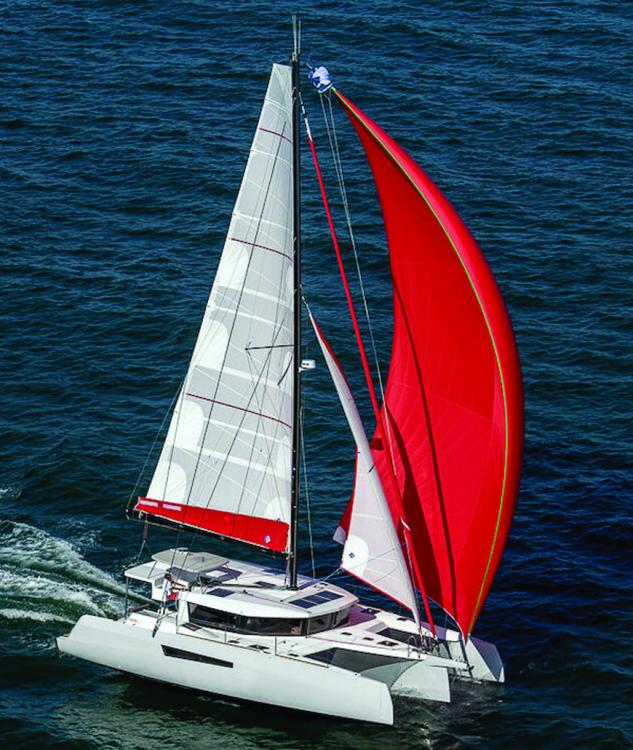The Neel 47 Trimaran
Trimarans have had a long run in nautical history; early incarnations have been traced back to Polynesia. One of my first experiences with a trimaran was as a kid cruising the Caribbean, anchored at Roosevelt Rhodes Naval Station in Puerto Rico in the early 1970s. We were invited over for an evening of adult and kid fun. What I remember distinctly was that the entire interior was covered in red shag carpet (remember—1970s), wall to wall (ama-to-ama), which was totally alien to a nine-year old boy living in the plain Jane white interior of our 35-foot 1938 S&S sloop.

An abbreviated history
Neel Trimarans is a relative newcomer to the world of production multihulls with production starting in 2010. Based in La Rochelle, France, Neel Trimaran Company was started by Eric Bruneel, former general manager of Fountaine Pajot Catamarans and a talented multihull sailor with a successful career competing in offshore racing multihulls. Neel Trimarans currently offers 43-, 47-, 51-, and 65-foot models.
Neel 47
The Neel 47 is new to the lineup, having been introduced in 2019. The center hull has the bulk of the interior volume and is home to a high percentage of the usable space aboard. The interior, accommodations, and build quality should be considered above average.
The ultra-wide aft cockpit area utilizes most of the 27-foot beam. The aft cockpit extends forward directly into a port side saloon/dining area that is adjacent to a multihull style galley. The master state room occupies the starboard side of the main hull and opens directly to the galley and saloon area. The master head and shower are forward and down. With the exception of the master head and shower, all living space in the main hull, including the aft deck, is on the same level.
With less usable horizontal space to utilize than on catamarans, the Neel 47 uses vertical space very effectively. Under the saloon/galley floor is a very spacious “technical room,” which houses fuel and water tanks, plumbing manifolds, and the AC and DC electrical systems including the batteries but minus the generator. The vessel I inspected was equipped with an advanced shore power setup, including dual input transformers allowing the boat to be fully functional on both U.S. and European power grids. Ample room remains for the installation of a watermaker, washer-dryer, air conditioning, and even bike storage.
The guest cabins are located in the port and starboard amas and are not directly accessible from the main cabin. Guest accommodations are not quite as spacious as the catamaran counterparts, due to the narrow beam and lower head room of the amas. Each guest cabin has its own small electric head, shower, and sink (the current configuration requires the steps to be removed and the head/commode swung into the companionway for each use): cute, but I have been told that this arrangement will be modified in future builds.
The engine space is accessible from a centerline deck hatch in the cockpit floor. Access to the engine, generator, and steering system (single rudder) was exceptional. The central location of the machinery, tankage, and electrical components keeps much of the weight in the center of the vessel, resulting in a huge influence in sailing performance.
A distinct departure from the standard catamaran configuration is the single engine vs. twins. This comes at a cost in maneuverability while under power, much of which has been countered with the installation of a decent bow thruster.
Considerations and observations
As I have only inspected one of these vessels, these observations should be at this point considered mostly unique to this individual Neel 47.
- The vessel I inspected had a very damp engine compartment. Salt residue was noted on the generator sound shield; some moderate corrosion was noted on both generator and main engine components and considered above average considering that the vessel was only nine months old. This could be due to operator error or possibly inherent in the current hatch and ventilation design.
- Many of the smaller bulkhead connections were secured with wide fillets of thickened resin, and small cracks were noted in the radius of several of the fillet bonds, none of which were considered structural.
- The electrical system was above average with high-quality components and an above-average degree of flexibility.
- The bow thruster was very handy and greatly appreciated with even just a light breeze trying to pin you to the dock (personal observation).
- The single rudder was very responsive, light to the touch, and could be compared to a racing monohull with half of the displacement.
- The beam was a consideration; at 27 feet wide, it took a little research to find a yard capable of hauling the boat for survey.
Availability
Confusing; as of August 1, per YachtWorld, there appeared to be seven available in the U.S. Closer inspection revealed that at least two listings were the same vessel, just different locations listed. Prices for U.S. listed boats ranged from $490,000 to $730,000.
About the Author: Capt. Tarn Kelsey owns and operates Kelsey Marine Survey in Annapolis.




